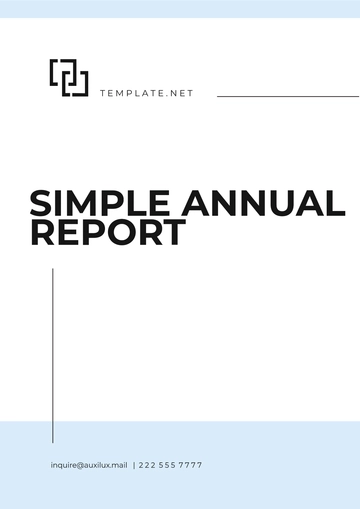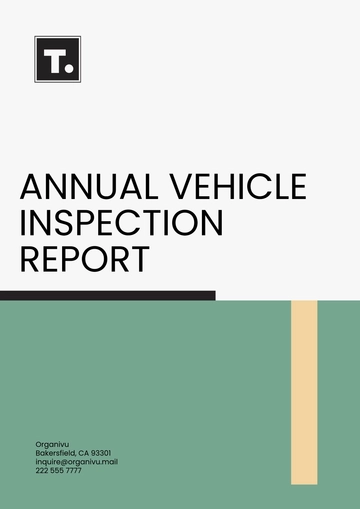Free Annual Job Report

Prepared by: [YOUR NAME]
Date: January 15, 2051
I. Executive Summary
This Annual Job Report provides a comprehensive analysis of job trends and employment statistics for the year 2050. It highlights key developments in the job market, presenting a detailed overview of employment patterns and job creation across various sectors. The report reflects an overall improvement in employment conditions compared to the previous year. It aims to equip stakeholders with actionable insights that can guide employment policies and strategic workforce planning.
II. Introduction
The purpose of this report is to analyze the current state of the job market over the past year. It examines employment trends, sector growth, and emerging job opportunities, providing insights into the factors driving changes in employment statistics. Data for this report is derived from government statistics, labor market studies, and industry reports to ensure an accurate and comprehensive analysis.
III. Job Market Overview
A. Employment Trends
The year 2050 witnessed steady growth in job opportunities across various sectors. The following table summarizes employment statistics for key sectors:
Sector | Employment (in thousands) | Growth Rate (%) |
|---|---|---|
Technology | 3,500 | 5.2 |
Healthcare | 4,200 | 6.3 |
Finance | 2,100 | 3.8 |
In 2050, the overall employment landscape improved, with notable job creation driven by advancements in technology and an increased demand for healthcare services.
B. Sector Analysis
Several sectors experienced significant growth, with technology and healthcare leading the charge. Emerging technologies such as artificial intelligence and machine learning created new job roles, expanding hiring in the tech sector. Additionally, the aging population and increased healthcare needs propelled job growth in the healthcare sector.
IV. Key Findings
Key insights from the job market analysis include:
Primary Drivers: The technology and healthcare sectors were the primary drivers of job growth, with an increasing number of roles emerging due to technological advancements.
Remote Work: Remote work flexibility remained a significant factor for employee retention, influencing job satisfaction and productivity.
Emerging Roles: New job roles in technology, particularly those related to AI and automation, have emerged, highlighting the need for a workforce prepared for technological integration.
V. Challenges and Opportunities
A. Challenges
Despite the positive trends, several challenges remain:
Skills Gap: There is a growing skills gap in the labor market, with a pressing need for better alignment between educational qualifications and job requirements. For example, many employers report difficulties in finding candidates with the necessary technical skills for emerging roles.
Job Displacement: Job displacement due to automation continues to impact traditional roles, particularly in manufacturing and retail, where automation technologies have streamlined processes.
B. Opportunities
Opportunities exist for workforce re-skilling and up-skilling to match evolving job requirements:
Training Initiatives: Programs aimed at reskilling workers for technology-driven roles can help bridge the skills gap and enhance employability.
Entrepreneurship: Promoting innovation and startup ecosystems can spur further job creation and economic growth, particularly in the technology and service sectors.
VI. Recommendations
The report recommends the following actions for stakeholders:
Invest in Education: Focus on education and training programs tailored to emerging job roles, particularly in technology and healthcare.
Support Remote Work: Enhance policies to support remote work and flexible working conditions to boost employee satisfaction and retention.
Foster Innovation: Promote innovation and startup ecosystems to drive job creation and economic growth, providing resources and support for entrepreneurs.
VII. Conclusion
The job market in 2050 showed promising growth, particularly in sectors driven by technological advancements and healthcare needs. Addressing challenges such as the skills gap and preparing for future job trends will be crucial for sustaining employment opportunities. The insights provided in this report should help inform strategic decisions to enhance workforce readiness and economic resilience.
- 100% Customizable, free editor
- Access 1 Million+ Templates, photo’s & graphics
- Download or share as a template
- Click and replace photos, graphics, text, backgrounds
- Resize, crop, AI write & more
- Access advanced editor
Transform your annual reporting process with the Annual Job Report Template from Template.net. This fully editable and customizable template allows you to comprehensively summarize your yearly achievements, challenges, and strategic goals. Designed for professionals seeking clarity, it enables easy modifications to align with your specific needs. Enhance communication and foster accountability within your team while ensuring a thorough overview of progress and performance throughout the year.
You may also like
- Sales Report
- Daily Report
- Project Report
- Business Report
- Weekly Report
- Incident Report
- Annual Report
- Report Layout
- Report Design
- Progress Report
- Marketing Report
- Company Report
- Monthly Report
- Audit Report
- Status Report
- School Report
- Reports Hr
- Management Report
- Project Status Report
- Handover Report
- Health And Safety Report
- Restaurant Report
- Construction Report
- Research Report
- Evaluation Report
- Investigation Report
- Employee Report
- Advertising Report
- Weekly Status Report
- Project Management Report
- Finance Report
- Service Report
- Technical Report
- Meeting Report
- Quarterly Report
- Inspection Report
- Medical Report
- Test Report
- Summary Report
- Inventory Report
- Valuation Report
- Operations Report
- Payroll Report
- Training Report
- Job Report
- Case Report
- Performance Report
- Board Report
- Internal Audit Report
- Student Report
- Monthly Management Report
- Small Business Report
- Accident Report
- Call Center Report
- Activity Report
- IT and Software Report
- Internship Report
- Visit Report
- Product Report
- Book Report
- Property Report
- Recruitment Report
- University Report
- Event Report
- SEO Report
- Conference Report
- Narrative Report
- Nursing Home Report
- Preschool Report
- Call Report
- Customer Report
- Employee Incident Report
- Accomplishment Report
- Social Media Report
- Work From Home Report
- Security Report
- Damage Report
- Quality Report
- Internal Report
- Nurse Report
- Real Estate Report
- Hotel Report
- Equipment Report
- Credit Report
- Field Report
- Non Profit Report
- Maintenance Report
- News Report
- Survey Report
- Executive Report
- Law Firm Report
- Advertising Agency Report
- Interior Design Report
- Travel Agency Report
- Stock Report
- Salon Report
- Bug Report
- Workplace Report
- Action Report
- Investor Report
- Cleaning Services Report
- Consulting Report
- Freelancer Report
- Site Visit Report
- Trip Report
- Classroom Observation Report
- Vehicle Report
- Final Report
- Software Report





























